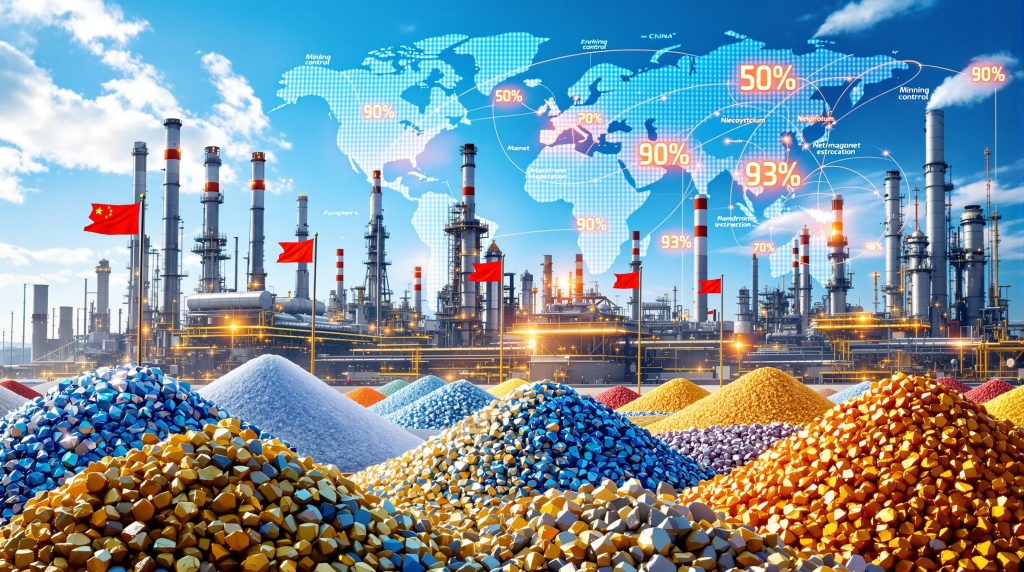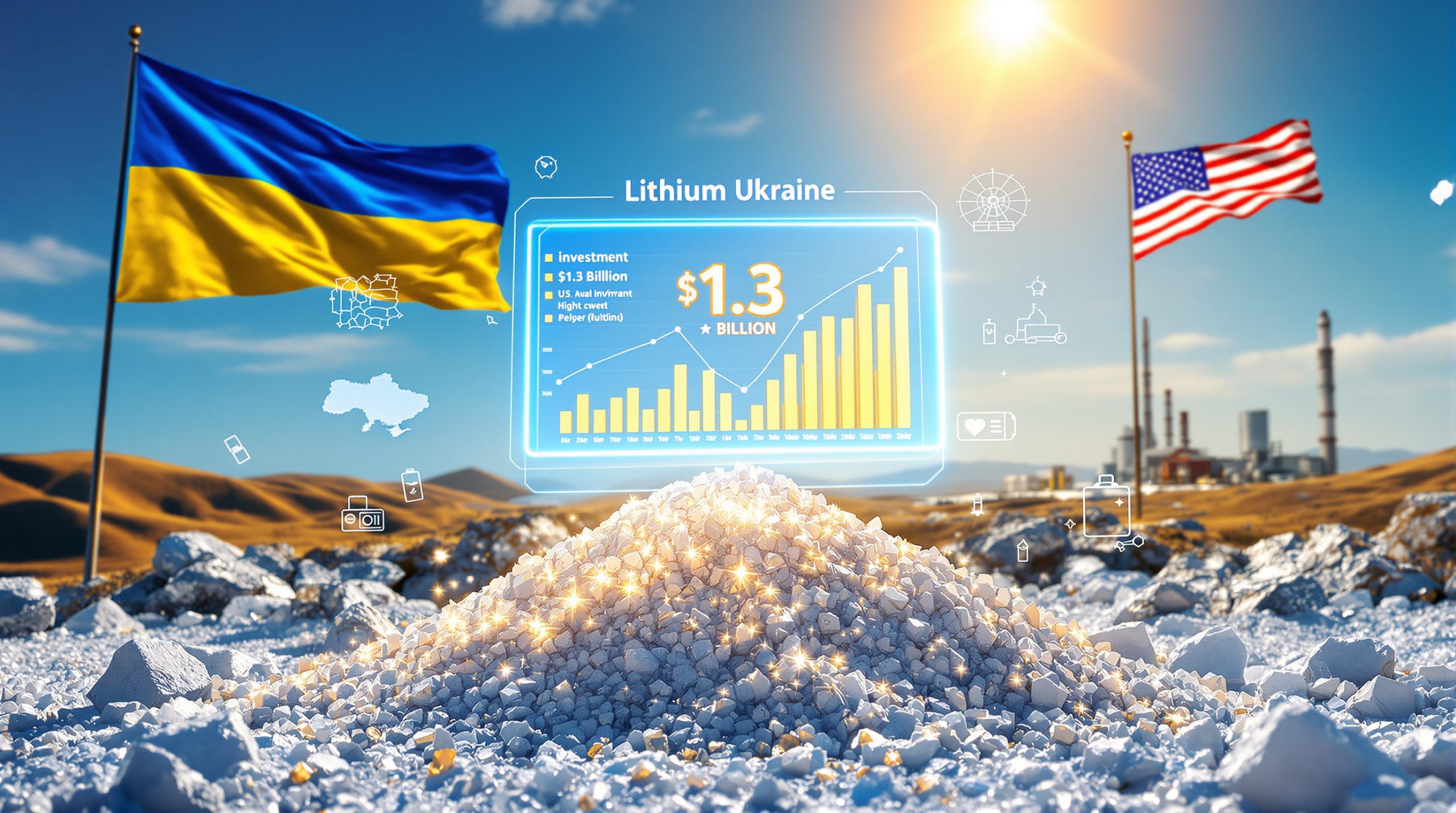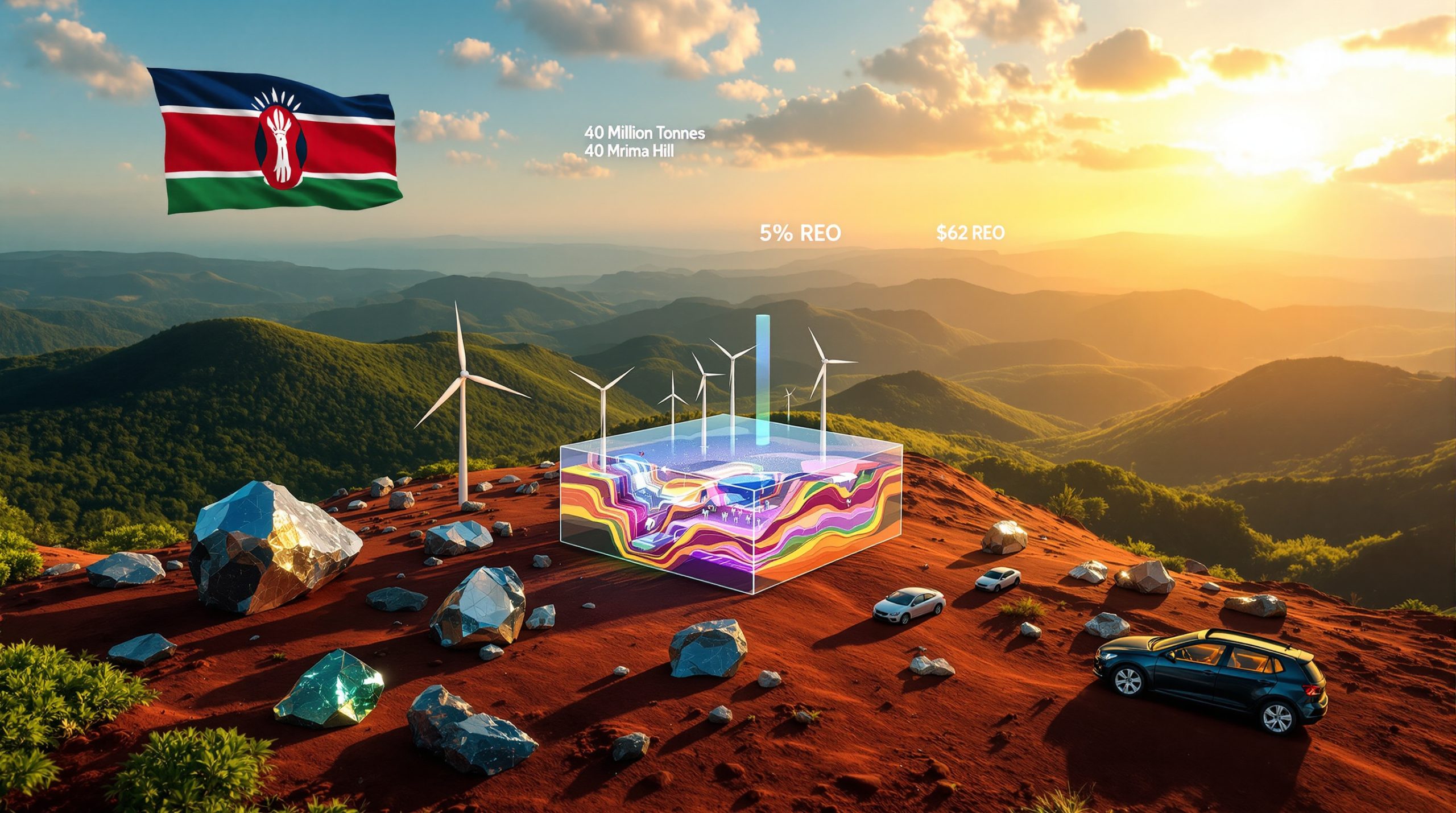China's dominance in global rare-earth processing continues to shape international supply chains, despite recent diplomatic developments suggesting potential policy shifts. China's control over rare-earth processing remains fundamentally unchanged, with the country maintaining approximately 90% of global separation and refining capacity. This concentration represents a strategic chokepoint that extends far beyond simple mining operations, affecting industries from electric vehicles to defence systems.
Furthermore, the technical barriers to establishing alternative processing capacity far exceed those of raw material extraction. Understanding this distinction is crucial for investors, policymakers, and industry stakeholders navigating an increasingly complex geopolitical landscape shaped by critical minerals security concerns.
What Makes China's Rare-Earth Processing Monopoly So Powerful?
The Scale of Beijing's Processing Dominance
China's position in rare-earth processing extends far beyond simple market leadership. The country's infrastructure encompasses the critical chemical processes that transform mixed rare-earth concentrates into individual elements suitable for high-technology applications.
The processing infrastructure encompasses several strategic elements:
• Dysprosium and terbium separation for high-temperature permanent magnets
• Neodymium and praseodymium refining essential for electric vehicle motors
• Specialised chemical facilities capable of handling complex separation processes
• Integrated alloy production linking refined elements to finished magnet manufacturing
This vertical integration creates multiple leverage points throughout the supply chain, making alternative sourcing strategies significantly more complex than simply identifying non-Chinese mining operations.
Why Processing Infrastructure Determines Global Power
The technical complexity of rare-earth processing creates natural barriers to competition that extend well beyond typical manufacturing challenges. Chemical separation requires sophisticated solvent extraction systems, precise temperature and pH control, and specialised handling of hazardous materials.
Capital Requirements for New Facilities:
| Infrastructure Component | Investment Range | Timeline |
|---|---|---|
| Separation plant construction | $2-5 billion | 5-8 years |
| Environmental compliance systems | $500M-1B | 3-7 years |
| Technical expertise development | Variable | 5-10 years |
| Market validation and scaling | Variable | 7-15 years |
The environmental considerations add another layer of complexity. Rare-earth processing generates significant quantities of radioactive and chemical waste, requiring sophisticated containment and treatment systems. Additionally, many Western jurisdictions maintain stricter environmental standards than those historically applied in China, increasing both costs and development timelines.
Quality control represents an additional technical hurdle. High-performance applications demand rare-earth elements with purity levels exceeding 99%, requiring precise control of separation parameters and comprehensive testing protocols.
How Did China Build Its Rare-Earth Processing Empire?
Strategic Industrial Development Through Decades
China's dominance in rare-earth processing emerged through deliberate industrial policy rather than natural resource advantages alone. Beginning in the 1980s, Chinese authorities implemented coordinated strategies to develop domestic processing capabilities whilst gradually restricting exports of raw materials.
The development approach included several key elements:
• Coordinated government investment in research institutions and pilot facilities
• Technology acquisition through joint ventures and academic exchanges
• Consolidation of domestic operations to achieve economies of scale
• Environmental policy frameworks that externalised certain costs during the development phase
This systematic approach created cost advantages that proved difficult for international competitors to match, particularly as global demand expanded with the growth of renewable energy sectors.
The Strategic Focus on Value-Added Manufacturing
Rather than competing primarily on raw material exports, China positioned itself as the global centre for processed rare-earth products. This strategy involved developing integrated supply chains linking mining operations to finished magnet production, creating multiple revenue streams and technical advantages.
The value chain progression includes:
- Raw ore extraction from domestic and international sources
- Concentration and preliminary processing at mining sites
- Chemical separation into individual rare-earth elements
- Alloying and metallurgical processing for specific applications
- Magnet manufacturing and component assembly
This vertical integration strategy allowed Chinese companies to capture value at each processing stage whilst developing technical expertise across the entire supply chain.
Recent Export Control Developments and Their True Impact
The Evolution of China's Export Licensing Framework
Recent policy adjustments have drawn significant attention from industry observers. China implemented updated export control measures affecting key rare-earth elements, including scandium, yttrium, samarium, gadolinium, terbium, dysprosium, and lutetium in 2025.
However, the practical impact of these adjustments may be more limited than initial coverage suggested. China temporarily suspended certain October 2025 provisions, reverting to the earlier April 2025 export-licensing framework. Importantly, Chinese authorities retain full discretionary power to reactivate stricter measures at any time.
Understanding the Administrative Nature of Policy Changes
The recent adjustments appear primarily administrative rather than representing fundamental strategic shifts. Key elements include:
• Modified language around military end-use classifications
• Retention of licensing requirements for critical elements
• Continued end-user verification processes
• Preserved discretionary authority for future policy implementation
Industry filings indicate that the same supply chain bottlenecks persist for dysprosium, terbium, neodymium, praseodymium, and high-purity graphite anode materials. Consequently, licensing procedures still require detailed documentation of intended applications and final users.
"Investment Reality Check: Administrative policy adjustments do not create new processing facilities or alter the fundamental concentration of separation capacity within China."
Why Export Policy Changes Miss the Fundamental Issue
Processing Capacity as the True Strategic Bottleneck
Export control policies, whilst important for short-term supply management, do not address the underlying structural dependency on Chinese processing infrastructure. The global rare-earth industry relies on Chinese facilities for the complex chemical processes that transform raw ores into usable materials, regardless of export documentation requirements.
This processing concentration creates several layers of dependency:
• Technical expertise concentrated in Chinese research institutions and companies
• Specialised equipment designed and manufactured primarily in China
• Process optimisation knowledge developed through decades of commercial operation
• Quality control systems calibrated for specific customer requirements
Even if export licences become more readily available, the physical capacity to produce processed rare-earth elements remains overwhelmingly located within Chinese borders.
The Inadequacy of Administrative Solutions
Focusing on export policy changes rather than processing capacity development may create false confidence among industry stakeholders. Key limitations include:
- Licensing flexibility does not expand global processing capacity
- Administrative adjustments can be reversed rapidly
- Political negotiations do not address technical barriers to competition
- Short-term agreements may obscure long-term strategic vulnerabilities
The fundamental challenge remains the absence of commercially viable alternatives to Chinese processing facilities. Until non-Chinese operations achieve reliable production at competitive costs, administrative policy changes serve primarily as tactical adjustments.
Companies Attempting to Build Alternative Processing Capacity
Current Western Rare-Earth Processing Ventures
Several companies are working to establish processing capabilities outside China, though each faces significant technical and financial challenges. These ventures represent the most credible paths towards supply chain diversification, supporting global critical minerals reserve initiatives.
Lynas Corporation operates the most advanced non-Chinese rare-earth processing facility at its Lynas Advanced Materials Plant in Malaysia. The company processes rare-earth concentrates from its Mount Weld mine in Western Australia, producing separated rare-earth products for global markets.
Energy Fuels has announced plans to develop rare-earth processing capabilities at its White Mesa Mill facility in Utah. The company aims to leverage existing uranium processing infrastructure to handle rare-earth separation, though commercial production timelines remain under development.
Ucore Rare Metals focuses on developing proprietary separation technologies through its Strategic Metals Complex project. The company emphasises technological innovation as a path to cost competitiveness, though commercial validation remains in progress.
Arafura Resources pursues an integrated approach through its Nolans Rare Earths Project in Australia's Northern Territory. This strategy combines mining and processing at a single location, potentially reducing logistical costs whilst improving supply chain control.
Timeline Realities for Supply Chain Independence
Despite significant investments and development efforts, achieving commercial-scale production outside China faces substantial challenges. Technical Development Requirements typically require 3-5 years of pilot-scale testing, with commercial-scale validation adding another 2-4 years.
Financial and Market Challenges include capital raising for multi-billion dollar facilities, long-term purchase agreements needed to justify investments, and achieving cost competitiveness with established Chinese operations.
The most optimistic scenarios suggest that meaningful alternative processing capacity could emerge within 5-10 years, assuming sustained financial support and successful technical execution. However, these developments reflect broader mining industry evolution trends requiring patient capital and coordinated support.
Geopolitical Implications for Global Industries
Industries Most Vulnerable to Supply Disruptions
China's control over rare-earth processing creates strategic vulnerabilities across multiple technology sectors. The concentration of separation and refining capacity affects industries far beyond traditional manufacturing, extending into emerging technology areas critical for economic competitiveness.
Electric Vehicle Manufacturing represents perhaps the most significant exposure. Modern electric vehicles require substantial quantities of neodymium and praseodymium for permanent magnet motors, with dysprosium additions for high-temperature performance applications.
Wind Energy Infrastructure relies heavily on rare-earth permanent magnets for direct-drive generators. These applications require particularly high-performance materials, with dysprosium and terbium essential for maintaining magnetic properties under varying operational conditions.
Defence and Aerospace Applications utilise rare-earth elements across multiple systems, including precision-guided munitions, radar systems, communications equipment, and propulsion components. The specialised requirements and long qualification cycles create additional supply chain vulnerabilities.
Strategic Response Options for Import-Dependent Nations
Governments and industry stakeholders have limited options for addressing rare-earth processing dependencies in the near term. Each approach involves significant tradeoffs between cost, timeline, and strategic effectiveness.
Strategic Stockpiling offers short-term supply security but requires substantial capital investment and ongoing maintenance costs. Determining appropriate stockpile sizes and compositions presents additional challenges, particularly for processed materials with specific shelf-life considerations.
Diplomatic Engagement can help manage relationships and reduce the likelihood of supply disruptions, but provides limited protection against unilateral policy changes or escalating geopolitical tensions.
Technology Development for Recycling and Substitution represents longer-term solutions but requires sustained research and development investment without guaranteed success timelines. These efforts connect to broader mineral beneficiation insights regarding value-added processing.
Investment Implications and Risk Assessment
Key Metrics for Evaluating Supply Chain Exposure
Investors analysing companies with rare-earth exposure should focus on processing-stage dependencies rather than simply evaluating raw material sourcing patterns. Critical assessment metrics include:
• Percentage of rare-earth inputs sourced from Chinese processing facilities
• Processing stage dependencies beyond raw ore extraction
• Alternative supplier qualification status and timelines
• Inventory management strategies and stockpile adequacy
• Cost sensitivity to supply chain diversification efforts
Companies with direct dependencies on Chinese separation and refining operations face higher strategic risks than those relying primarily on raw ore imports.
Investment Opportunities in Processing Infrastructure Development
The development of alternative rare-earth processing capacity represents a significant investment opportunity, though one characterised by extended timelines and substantial execution risks. Key factors for evaluation include technical competency, financial resources, market positioning, and geographic advantages.
Technical Competency: Companies demonstrating proprietary separation technologies or operational expertise in similar chemical processes may possess competitive advantages in facility development.
Financial Resources: The multi-billion dollar capital requirements for commercial-scale processing facilities favour companies with access to patient capital or government support programmes.
"Strategic Investment Focus: Concentrate on companies developing separation and refining capabilities rather than mining operations alone, as processing represents the true strategic bottleneck in rare-earth supply chains."
Future Scenarios for Rare-Earth Processing Control
What Could Reshape Global Processing Dynamics?
Several scenarios could reshape global rare-earth processing dynamics over the next decade, each with distinct implications for industry stakeholders and investment strategies.
Gradual Western Capacity Development represents the most likely scenario, with alternative processing facilities achieving commercial operation through sustained investment and technical development. This path involves extended timelines but offers the most sustainable approach to supply chain diversification.
Continued Chinese Market Dominance remains plausible if alternative capacity development faces sustained technical or financial challenges. In this scenario, China's control over rare-earth processing would persist, with export controls serving as the primary mechanism for supply management.
Technology Breakthrough Possibilities in recycling or processing efficiency could accelerate alternative capacity development or reduce overall rare-earth demand. However, such breakthroughs remain speculative and difficult to predict.
Critical Success Factors for Breaking Processing Monopolies
Successful development of alternative rare-earth processing capacity requires alignment of multiple challenging factors:
• Sustained financial commitment from both government and private sources
• Technical talent development and knowledge transfer from existing expertise centres
• Regulatory frameworks balancing environmental protection with strategic objectives
• Long-term purchase agreements providing revenue certainty for facility investments
• Coordinated industry cooperation to achieve necessary economies of scale
The absence of any single factor could jeopardise alternative capacity development, whilst success requires simultaneous progress across all dimensions. These developments support Australia's aspirations for green metals leadership in the emerging clean energy economy.
Understanding the Path Forward
Separating Political Rhetoric from Supply Chain Reality
Recent diplomatic developments and policy adjustments, whilst politically significant, do not alter the fundamental structure of global rare-earth processing capacity. China's strategic leverage derives from physical infrastructure and technical capabilities rather than administrative policies alone.
Industry stakeholders must distinguish between short-term policy changes and long-term structural dependencies when making strategic decisions. Export control adjustments may affect immediate procurement processes, but they do not create alternative processing facilities.
The Imperative for Alternative Capacity Development
Meaningful reduction in rare-earth processing dependencies requires sustained commitment to developing alternative separation and refining capabilities. This development process demands patient capital, technical expertise, and coordinated industry support over extended timelines.
The companies currently pursuing alternative processing capacity represent the most credible pathway towards supply chain diversification. However, their success depends on continued financial support, technical execution, and market validation across multiple challenging dimensions. China's control over rare-earth processing will likely persist until these alternative facilities achieve commercial viability and scale.
Disclaimer: This analysis involves forward-looking statements regarding rare-earth market developments, company performance, and geopolitical scenarios. Actual results may differ materially from projections due to technical, financial, regulatory, or market factors. Investment decisions should be based on comprehensive due diligence and risk assessment appropriate to individual circumstances.
Want to Stay Ahead of Critical Minerals Developments?
Discovery Alert's proprietary Discovery IQ model delivers real-time notifications on significant ASX mineral discoveries, including emerging opportunities in critical minerals and rare earth sectors. Join thousands of investors who rely on our advanced AI technology to identify actionable opportunities before they hit mainstream attention, and explore our dedicated discoveries page showcasing historic examples of transformative market outcomes.




